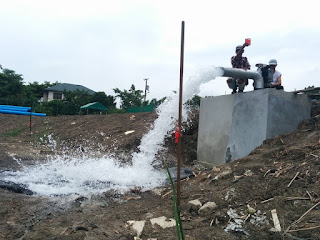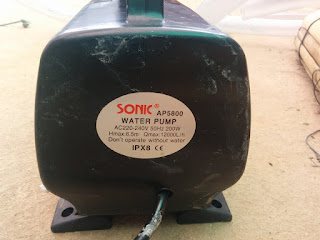We purchased a “pump payanak” from a local agricultural machines shop. (This maybe translates to “naga pump” in English. Because of the shape?) It has a 2.2kW Mitsubishi motor mounted to a belt that drives an impeller. The impeller is mounted vertically inside an 8″ stainless steel pipe. Thus, when the impeller turns on, it pushes the water up and out of the pipe.
The overall cost of the setup was about 30k THB (a little less than $1000 US).
(Technical trivia: as best as I can tell, an impeller and a propeller are basically the same thing. At least in the “axial flow” case. But if you are propelling a boat with it, then it is a propeller. If you are simply pushing water with it, then it is an impeller. Of course, the shape of the blades will differ if you are optimizing it for different use cases. Just in case you are wondering what an “impeller” is.)
Here is a picture of our first test of it:
 |
| “pump payanak” |
It ran at about 18.2 amps at 220VAC and was able to pump about 90 liters per second. That is a ridiculously high rate of water flow. Although my target was 100 liters per second, I really didn’t expect to come anywhere close.
For reference, here is my water flow rate target calculation:
- The pond is about 1800 m^2 and should have an average depth of about 1.5m
- This comes out to about 2700 m^3 of water
- When pumping water at maximum flow rate, I would like the turn-over rate for a single pump to be about once every 8 hours, which comes out to 337.5 m^3/hour, or about 94 liters per second
With more than one pump, we could see turnover rates of better than once per 8 hours. For reference, the CDC (the US Centers for Disease Control) recommends a turnover rate of at least once every 6 hours in residential swimming pools, but since I am planning to have about 3 of these pumps, this system shouldn’t have any problem meeting that target.
On the other hand, I’m not confident that the “pump payanak” is the best design for me here. Too much pumping up and then dropping the water down. Logically, this should lead to wasted energy. I’m considering cutting a hole in the side of the cistern and mounting a boat propeller type system to simply push the water through the wall. (The cistern will be fed by 12″ PVC pipe from the planted regeneration zone/biofilter.) Additionally, this design will disrupt the water less, so it is less likely to kill off the healthy and balanced micro flora and fauna in the water. While this design seems better for my needs, it will unfortunately require some custom engineering, which always takes more time and energy than one expects. We’ll see if I can run some quick proof-of-concept tests on this idea, though.
For the second pump, I bought a 200W “large sized aquarium pump”.
I used it to fill up the cistern, and timed it for comparison. It is rated at a maximum flow rate of 12000 L/hr, but I measured it at 2.1 L/sec, which comes out to only about 7500 L/hr. It cost about 10x less than the “pump payanak” but it appears to pump about 45x less water.
I measured the initial startup power at right about 200W, but it settles into about 150W as things get up to speed. From this, we get about 10.5 liters per second per kW.
For comparison, the “pump payanak” uses 18.2 A at 220V, so if we approximate this as 18.2*220=4kW, we get 90/4=22.5 liters per second per kW. By these rough calculations, the “pump payanak” is about 1.6x more energy efficient than the aquarium pump.
This is to be expected. The “pump payanak” is an axial flow pump, meaning that the flow of water is parallel to the axis of rotation of the impeller. Most pumps that you see in houses or aquariums are radial flow pumps, meaning that water is ejected radially from the spinning impeller. (Think “blower fan” vs. “normal desk fan”.) Radial flow pumps can push water up to much higher heads (i.e. higher difference in elevations), but have much lower flow rates at lower heads. Axial flow pumps have very limited heads (<4m) but are designed for much higher flow rates at these lower heads.
Using some tables I found on the internet, I’ve calculated that the friction loss of 100 L/sec of water flow through the length of 12″ PVC pipe I’m using is equivalent to only .3m of head, so an axial flow pump should be much more efficient here. Particularly if I can avoid pumping the water over the wall of the cistern.


18.2 Amps (4kW input power) for a 2.2kW motor is only slightly over 50% efficiency. I think this is too low. I grew up with "naga pump" driven by a gasoline or diesel engine but I really have no experience on optimizing an AC motor efficiency. How ever if you are interested in optimizing energy I have 2 ideas that might help. 1) if low efficiency was resulted from low power factor (due to the inductive characteristic of the motor) then introducing a power factor correction circuit may help (just add a capacitor). It may not help if the efficiency of the motor itself was the limitation. But I guess at worst most induction motor should have >70% efficiency. 2) Once you are settle with your pump setup, changing pulley ratio may improve efficiency too.
Very good points. The motor is a Mitsubishi "Super Line". It is rated at 15.1A at 220V, so I am overspec by a little on this test. (Even though this was the way the shop gave it to me.)
I did buy a few different pulley sizes to try adjusting that, too. (More on that later if I get to it. I'm currently exploring a completely different direction. Will post that soon.)
So at the rated amps and volts and assuming the capacitor box I bought from the shop is correct (the recommended capacitor sizes are on the nameplate, so I'll definitely double check this), then this motor is 67% efficient at the rated output. This is pretty close to your 70% number, but I agree with you that it isn't very impressive.
But I have to start somewhere and then improve from there.
And with regards to the pulleys, at the very least I would like to reduce the ratio so that it draws closer to the rated 15A.
I just pulled the 70% efficiency number from the sky. I don't really know the norm of induction motor efficiency. It could be lower or higher So don't rely on this number 🙂 . One more thought, at the exit-mouth of the pump where the water coming out, if you can extend the pipe and make the end of it as low as possible to the ground it should save some power. Because the height-different between the inlet water-level and outlet water-level will be smaller.
This comment has been removed by a blog administrator.